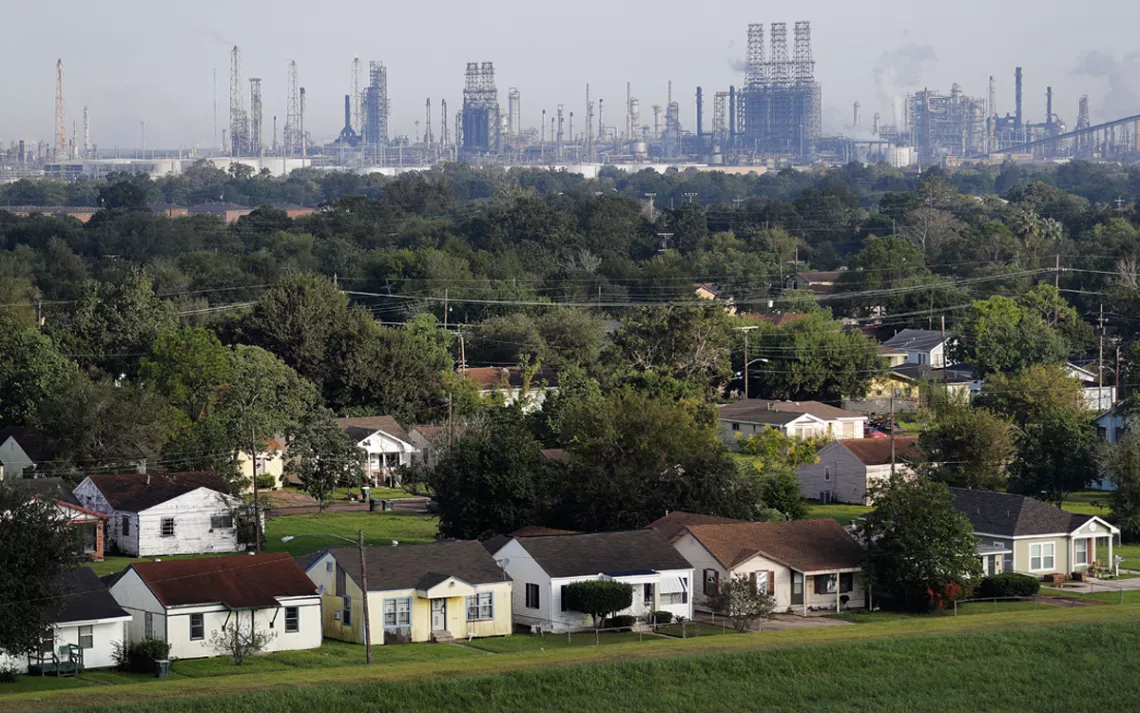Environmental Justice Advocates Respond to the Inflation Reduction Act
While some celebrate the billions of dollars for disadvantaged communities, others say compromises in the act put those same communities at risk

A residential neighborhood next to an oil refinery in Port Arthur, Texas, in 2017. | Photo by AP Photo/David Goldman
On August 16, President Joe Biden signed into law a historic investment to address climate change, including funds for renewable energy, clean manufacturing, and environmental justice. The Inflation Reduction Act has the potential to slash the United States’ carbon emissions by 40 percent by 2030 and includes billions of dollars designated for low-income areas. But for many environmental justice advocates, the climate wins come with compromises that are hard to accept.
The act includes climate and pollution project grants for communities, tax credits for wind and solar that benefit low-income areas, among other environmental justice spending. An independent analysis by the Just Solutions Collective estimates that the act offers $47.5 billion to environmental justice priorities. Advocates say those investments are crucial to address historic inequities and unequal environmental risks. “We’re cautiously optimistic because this is by far one of the largest climate investments that has come through Congress at all,” says Abre’ Conner, NAACP director of environmental and climate justice.
The act mandates $3 billion in block grants for community-led projects to address climate change and pollution. “One of the things that’s so important for us at the NAACP is for individuals at the community level to be able to build power … the actual environmental justice funding at a community level, that’s something that I’m really excited about,” Conner says.
Other grants include $3 billion to improve transportation and infrastructure in neighborhoods and $3 billion to reduce air pollution at ports. The greenhouse gas reduction fund sets aside $15 billion for disadvantaged communities. There’s also spending to address air pollution in schools, improve access to drinking water, and clean up toxic Superfund sites.
Another potential boon to reduce energy costs and pollution is a tax credit for solar and wind projects that benefit low-income communities. “Having a tax credit is an important first step,” says Conner, but she knows there are many barriers to overcome before communities can see an impact from that investment. “You first have to have the property; you have to have the housing; you have to have all of those things in place in order to even utilize the tax credit.”
Some have raised concerns about the allocation process for distributing the grants funded by the act, which isn’t yet known. The money may be routed through individual states, explains Kendall Dix, national policy director at Taproot Earth. “What that means for communities in Louisiana, or Mississippi: You have state legislatures that [will] potentially hold on to the money … that are already hostile toward communities, especially Black, Indigenous, people of color,” he says. Dix is also worried about a competitive process to access grants and the potential logistic challenges for communities to apply. “You’re asking for people to have expertise and time and resources to [apply] for what can be really onerous paperwork burdens.”
While many environmental justice advocates welcome the Inflation Reduction Act, for others, the compromises negotiators offered to the oil and gas industry are too much to accept. The legislation directs the federal government to open land leases for oil and gas projects. Development on these leases could increase pollution and sacrifice communities from the Gulf South to Alaska, opponents say. While this doesn’t guarantee that the industry will purchase and develop on those leases, “it would be naïve to think that there will be no oil and gas development if there are required lease sales,” Dix says.
People of color are more likely to breathe polluted air and face health risks like asthma, diabetes, and heart disease. Low-income households are burdened by energy costs, spending three times more of their total income to keep the lights on than non-low-income households. Disadvantaged communities are also more likely to suffer from extreme heat and extreme weather events, which are intensifying with climate change.
“The Inflation Reduction Act is not a climate justice bill,” declared the Climate Justice Alliance (an organization that represents 84 communities and nonprofits, including Taproot Earth) in a statement. The act also offers funding for carbon sequestration, nuclear power, and hydrogen, which the Climate Justice Alliance opposes as inadequate and risky responses to the threat of climate change. Others see these technologies as crucial steps to reduce emissions.
Now that the Inflation Reduction Act has passed, many environmental justice advocates are turning their attention to a permitting-reform side deal between Senator Joe Manchin (D-W.Va.) and leading Democrats. The legislation could change the process for approving energy projects, from oil and gas pipelines to renewable energy development. The draft bill would streamline oversight required by the National Environmental Policy Act, potentially speeding projects outlined in the Inflation Reduction Act. But Dix says NEPA is essential to protecting poor people and the environment, and that the side deal could put environmental justice concerns at risk.
The Sierra Club supports the Inflation Reduction Act but recognizes the concerns of communities most impacted by the oil and gas industry. “We’re not just letting this slide,” says Leslie Fields, Sierra Club national director, policy advocacy and legal. “A lot of environmental justice groups are very unhappy for good reason.” The organization plans to be vigilant throughout the act’s rollout and stay involved at the federal and state level.
“We are excited about the celebration,” says Conner of the NAACP. “But we also understand that this is just the beginning.”
 The Magazine of The Sierra Club
The Magazine of The Sierra Club



